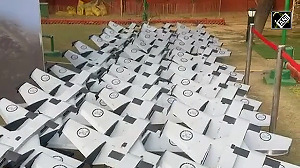Even in Las Vegas, a city not known for understatement, the overhaul of the Tropicana Casino & Resort is grandiose. When the $2 billion face-lift is completed in 2010, the hotel will have more than 10,200 rooms, a new convention center and shopping mall, parking for 6,200 cars, and multiple pools.
That's great for gamblers, but it's a big challenge for the architects putting all the pieces together.
"It's like building three mega-resorts at once," says Jim Stapleton, vice-president of Cincinnati-based FRCH Design Worldwide, the lead architect on the project. Adding to the complexity, gaming tables and sections of the hotel will remain open through the renovation. Worse, it's happening at a time when U.S. architects are in short supply.
Time to call India.
In a cramped office in Kolkata, some 8,000 miles from the Strip, dozens of Indian architects spend their days and often nights generating plans for the Tropicana. They work for Cadforce Inc., a Marina del Rey (Calif.) startup that is helping bring offshore outsourcing to yet another U.S. sector.
All told, Cadforce has some 150 designers and computer technicians in India and 41 in the U.S. working on a new hospital in San Diego, private homes, fast-food joints, and more. "The tidal wave of interest has just begun in the last year," says Cadforce CEO Robert W. Vanech, a venture capitalist who founded the company in 2001.
Cadforce is one of a growing number of companies jumping into the business. The $29 billion U.S. architecture industry ships about $100 million in work abroad each year, Cadforce estimates. Some 20% of U.S. firms say they are offshoring, according to a survey by Harvard University and the American Institute of Architects (AIA), while an additional 30% are considering doing so.
"Clients are demanding shorter and shorter turnarounds, smaller fees, and better details," says Harvard doctoral student David del Villar, who helped lead the study.
While the work isn't glamorous, many Indian architects say it's a great opportunity. Rather than developing complete designs, architects in these outsourcing shops tend to handle tasks such as turning schematic





